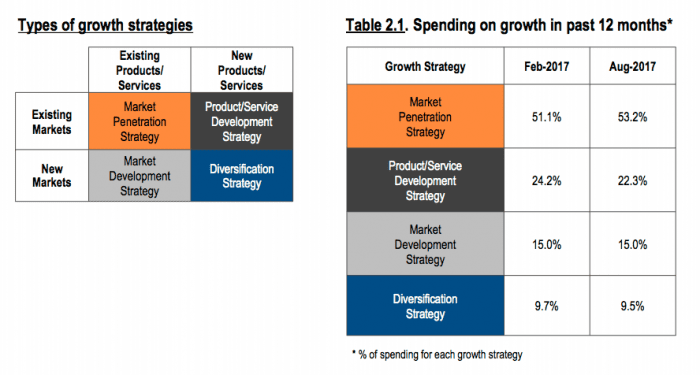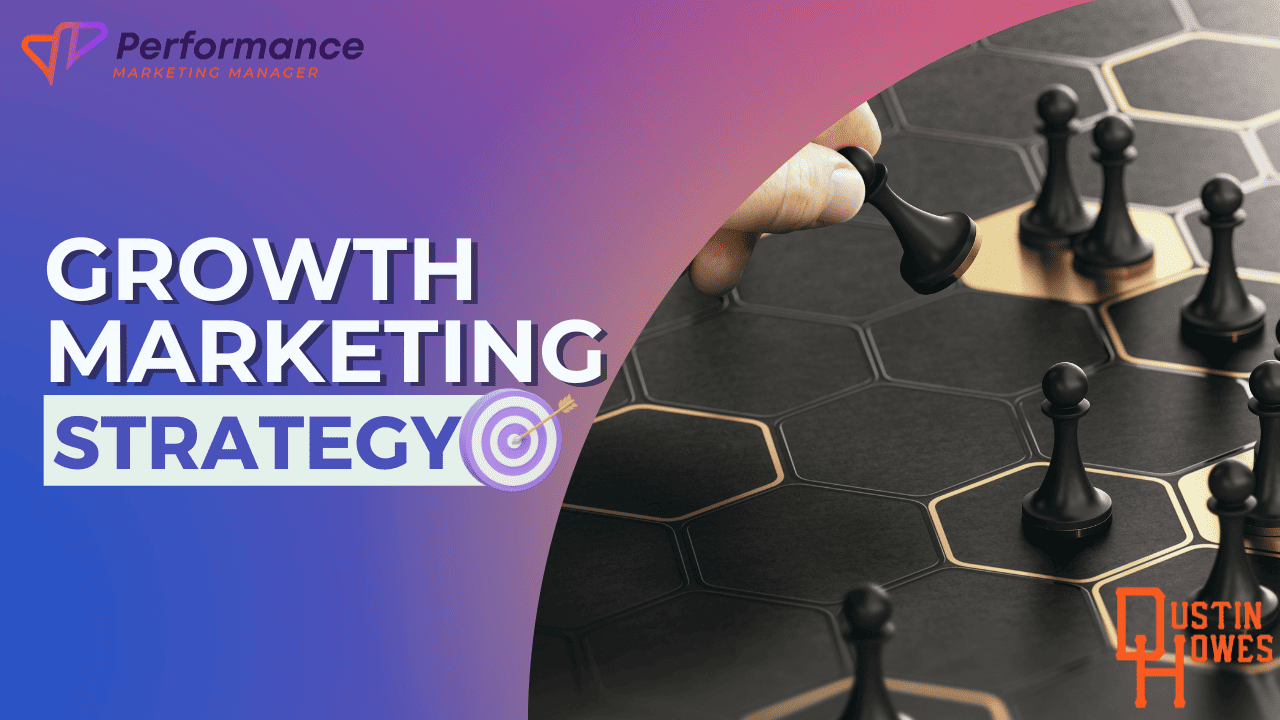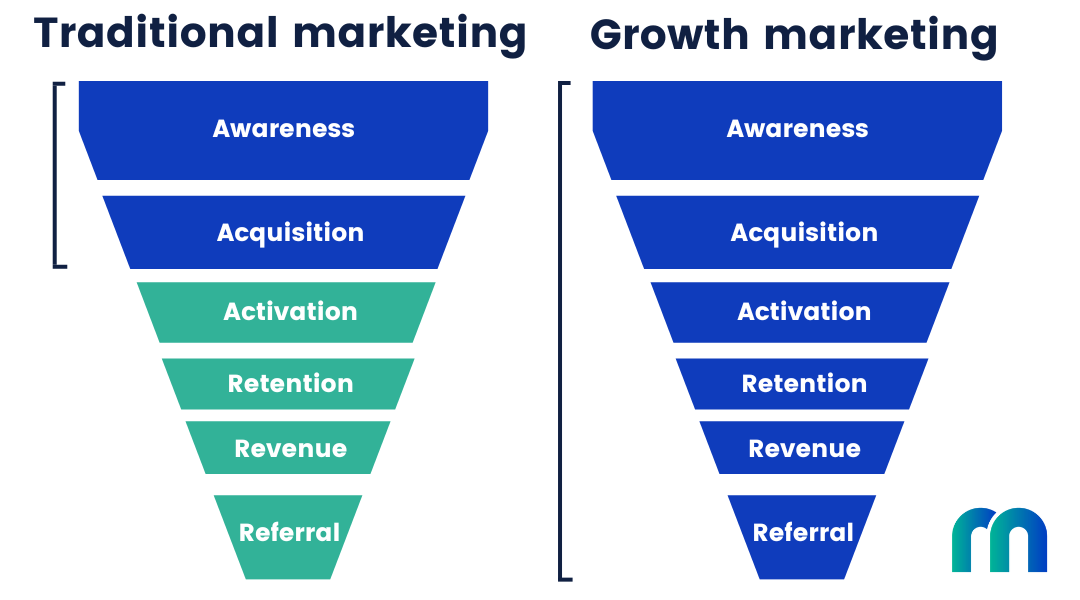Marketing-focused growth, at its core, prioritizes strategic marketing efforts to drive business expansion. Unlike product-led growth, which relies on product virality, this approach emphasizes targeted campaigns and meticulous audience engagement to achieve sustainable growth. This exploration delves into the intricacies of crafting and executing a successful marketing-focused growth strategy, from defining target audiences and developing comprehensive marketing plans to measuring results and optimizing campaigns for maximum return on investment.
We’ll examine various marketing channels, their relative strengths and weaknesses, and how to leverage them effectively. The creation of compelling content, tailored to specific audience segments, will also be a key focus, alongside the critical aspects of A/B testing and data-driven optimization. Through detailed case studies, we will analyze real-world examples of successful marketing-focused growth strategies, highlighting both triumphs and challenges encountered along the way.
Defining Marketing-Focused Growth

Marketing-focused growth prioritizes marketing strategies as the primary driver for business expansion. Unlike other growth models that might emphasize product development or sales, this approach leverages strategic marketing to attract, engage, and retain customers, ultimately fueling revenue growth. It’s about understanding your target audience deeply, crafting compelling messaging, and selecting the most effective channels to reach them.
Marketing-focused growth hinges on several core principles. First, a deep understanding of the target audience is paramount. This includes their demographics, psychographics, needs, and pain points. Second, a clear value proposition needs to be defined and communicated effectively. This value proposition must resonate with the target audience and highlight the unique benefits of the product or service. Third, data-driven decision-making is crucial. Regularly tracking key metrics like website traffic, conversion rates, and customer acquisition cost (CAC) allows for continuous optimization and improvement of marketing campaigns. Finally, consistent brand messaging across all channels ensures a unified and cohesive customer experience.
Key Differences Between Marketing-Focused and Other Growth Strategies
Marketing-focused growth differs significantly from other models, such as product-led growth (PLG). PLG relies on the product itself to drive user acquisition and engagement. Users experience the product’s value directly, leading to organic growth through word-of-mouth and virality. In contrast, marketing-focused growth actively promotes the product or service through various marketing channels. While PLG is often characterized by a bottom-up approach, marketing-focused growth employs a top-down strategy, proactively reaching potential customers. Sales-led growth, another alternative, emphasizes direct sales efforts and building strong relationships with individual clients. Marketing-focused growth, on the other hand, focuses on building brand awareness and generating leads at scale through broader marketing initiatives.
Comparison of Marketing Channels for Growth
The selection of appropriate marketing channels is critical for successful marketing-focused growth. Different channels offer varying levels of cost-effectiveness, reach, engagement, and conversion rates. The optimal strategy often involves a multi-channel approach, combining several methods to maximize impact.
| Marketing Channel | Cost | Reach | Engagement | Conversion Rates |
|---|---|---|---|---|
| Social Media Marketing | Low to High (depending on advertising spend) | High (depending on platform and targeting) | Medium to High (depending on content quality and engagement strategies) | Variable (depends on targeting and ad creative) |
| Email Marketing | Low to Medium | Medium to High (depending on email list size and segmentation) | Medium (depends on email content and personalization) | Medium to High (depending on email sequence and offer) |
| Content Marketing (Blog, Articles, etc.) | Low to Medium | Medium to High (depending on and content promotion) | Medium to High (depending on content quality and relevance) | Low to Medium (long-term strategy, builds brand authority) |
| Paid Advertising (PPC, Social Media Ads) | Medium to High | High (depending on budget and targeting) | Medium (depends on ad creative and targeting) | Variable (depends on targeting, ad copy, and landing page optimization) |
| Affiliate Marketing | Medium to High (performance-based) | Medium to High (depends on affiliate network and reach) | Medium (depends on affiliate promotion) | Variable (depends on affiliate’s audience and promotion) |
Identifying Target Audiences for Marketing-Focused Growth

Defining your target audience is paramount for effective marketing-focused growth. Without a clear understanding of your ideal customers, your marketing efforts will be scattered and inefficient, resulting in wasted resources and a poor return on investment. This section Artikels the process of identifying and profiling your target audiences to maximize your marketing impact.
Identifying the key characteristics of ideal customer profiles (ICPs) requires a deep understanding of your business and its offerings. It’s not just about demographics; it’s about understanding their needs, motivations, and pain points. This detailed knowledge allows for the creation of highly targeted marketing campaigns that resonate with your ideal customers and drive conversions.
Marketing-focused growth hinges on understanding your target audience and crafting compelling campaigns. A key aspect of this involves leveraging effective e-commerce strategies, and for that, exploring resources like E-commerce growth solutions can be incredibly beneficial. Ultimately, successful marketing-focused growth requires a holistic approach that integrates online and offline channels for maximum impact.
Ideal Customer Profile (ICP) Characteristics
Key characteristics of ideal customer profiles for marketing-focused growth include a combination of demographic, firmographic, and behavioral attributes. Demographic data includes factors such as age, location, gender, and income. Firmographic data focuses on company size, industry, revenue, and number of employees. Behavioral data considers website activity, engagement with marketing materials, and past purchasing history. Analyzing these characteristics helps to create a comprehensive picture of your ideal customer.
Buyer Personas
Developing detailed buyer personas allows for a more personalized and effective marketing approach. Below are three distinct buyer personas, each representing a different segment of our hypothetical target market for a SaaS project management tool:
- Persona 1: The Busy CEO – Demographics: 45-60 years old, male or female, high income, located in major metropolitan areas. Psychographics: Driven, results-oriented, time-constrained, values efficiency and ROI. Needs: A tool to streamline project management, improve team collaboration, and gain better visibility into project progress. Pain Points: Lack of time, inefficient communication, difficulty tracking project deadlines, and managing multiple projects simultaneously.
- Persona 2: The Project Manager – Demographics: 30-45 years old, predominantly female, mid-level income, located across various regions. Psychographics: Organized, detail-oriented, process-driven, values collaboration and clear communication. Needs: A tool to effectively manage tasks, track progress, assign resources, and communicate with team members. Pain Points: Difficulty managing multiple projects simultaneously, inconsistent team communication, and lack of real-time project visibility.
- Persona 3: The Startup Founder – Demographics: 25-35 years old, male or female, variable income, located in tech hubs or startup ecosystems. Psychographics: Innovative, risk-taking, budget-conscious, values scalability and flexibility. Needs: A cost-effective tool that can grow with their business, offering basic project management features with the potential for future expansion. Pain Points: Limited budget, need for a simple yet effective solution, and concerns about scalability and integration with other tools.
Target Audience Segmentation Based on Behavioral Patterns and Purchasing History
Segmenting your target audience based on behavioral patterns and purchasing history allows for highly targeted marketing campaigns. This data can be gathered through website analytics, CRM systems, and marketing automation platforms. Analyzing this data helps identify trends and patterns that can inform your marketing strategies.
- High-Value Customers: These customers have a history of high spending and frequent purchases. Marketing efforts should focus on retention and upselling opportunities.
- Inactive Customers: These customers haven’t made a purchase in a while. Marketing efforts should focus on re-engagement and reminding them of the value of your product or service.
- Trial Users: These customers are currently using a free trial or demo. Marketing efforts should focus on converting them into paying customers by highlighting the benefits of a full subscription.
- Website Visitors: These customers have visited your website but haven’t made a purchase. Marketing efforts should focus on lead nurturing and providing valuable content to guide them through the sales funnel.
Developing a Marketing-Focused Growth Strategy

A robust marketing-focused growth strategy is crucial for achieving sustainable business expansion. It involves a detailed plan that Artikels specific goals, the methods to achieve them, and a system for measuring success. This plan should be adaptable and responsive to market changes and customer feedback. Effective strategies are data-driven, leveraging analytics to refine approaches and maximize ROI.
Comprehensive Marketing Plan Design
A comprehensive marketing plan provides a roadmap for achieving marketing objectives. It begins with clearly defined goals, such as increasing brand awareness by 20% or generating 1000 new leads within a quarter. These goals should be SMART (Specific, Measurable, Achievable, Relevant, and Time-bound). Following goal definition, the plan Artikels specific strategies, such as content marketing, social media marketing, or paid advertising, to reach those goals. Tactics, the individual actions taken to execute strategies (e.g., running a specific social media campaign, publishing a blog post), are then detailed, along with specific timelines for implementation and evaluation. For example, a content marketing strategy might involve publishing three blog posts per week for three months, while a social media strategy could focus on daily posts across multiple platforms.
Marketing Budget Allocation
Effective budget allocation is vital for maximizing the return on investment (ROI) of marketing activities. The following table illustrates a sample budget allocation across different marketing activities. Note that this is a hypothetical example and the actual allocation will depend on various factors, including industry, target audience, and available resources.
| Activity | Budget Allocation | Expected ROI | Timeline |
|---|---|---|---|
| Content Marketing (Blog, Ebooks) | $5,000 | 15% (estimated lead generation) | 6 Months |
| Social Media Marketing (Paid Ads, Organic Content) | $7,000 | 20% (estimated website traffic increase) | 3 Months |
| Search Engine Optimization () | $3,000 | 10% (estimated organic traffic increase) | 12 Months |
| Email Marketing | $2,000 | 12% (estimated conversion rate) | Ongoing |
Key Performance Indicators (KPIs)
Measuring the success of a marketing-focused growth strategy requires tracking relevant KPIs. These metrics provide insights into the effectiveness of marketing activities and allow for data-driven adjustments. Examples of KPIs include website traffic, conversion rates, customer acquisition cost (CAC), customer lifetime value (CLTV), brand awareness metrics (social media mentions, brand searches), and return on ad spend (ROAS). By regularly monitoring these KPIs, businesses can identify what’s working, what’s not, and make informed decisions to optimize their marketing efforts. For instance, a low conversion rate might indicate a need to improve the website’s user experience or the messaging in marketing materials. Conversely, a high ROAS on a particular ad campaign might suggest allocating more budget to that channel. Regular KPI analysis is essential for continuous improvement and maximizing the effectiveness of the marketing strategy.
Content Strategy for Marketing-Focused Growth
A robust content strategy is the cornerstone of any successful marketing-focused growth initiative. It involves creating and distributing valuable, relevant, and consistent content to attract and retain a clearly defined audience — ultimately driving profitable customer action. This strategy must be aligned with your overall business goals and target audience personas, ensuring all content contributes directly to achieving your marketing objectives.
Effective content marketing goes beyond simply creating content; it’s about understanding your audience’s needs and providing solutions through various formats and channels. This ensures maximum reach and engagement, fostering brand loyalty and driving conversions.
Compelling Content Examples
The following examples illustrate how diverse content can support marketing-focused growth, each tailored to a specific audience and outcome.
- Example 1: Blog Post – “5 Ways to Improve Your Sleep Quality” (Target Audience: Health-conscious individuals aged 25-45; Intended Outcome: Drive traffic to website and generate leads for a sleep aid product; Call to Action: Download a free e-book with more sleep tips and a discount code for the product). This blog post provides valuable information on a topic relevant to the target audience. The e-book acts as a lead magnet, capturing contact information for future marketing efforts. The discount code incentivizes immediate purchase.
- Example 2: Video – “Behind the Scenes at Our Manufacturing Facility” (Target Audience: Potential B2B clients and investors; Intended Outcome: Build trust and transparency, showcase company values and capabilities; Call to Action: Visit our website to learn more about our services and partnerships). This video uses a behind-the-scenes approach to humanize the brand and showcase the company’s commitment to quality and ethical practices. It fosters trust and credibility among potential clients and investors. The CTA drives traffic to the website for further engagement.
- Example 3: Infographic – “The Ultimate Guide to Choosing the Right [Product Category]” (Target Audience: Consumers researching and comparing products within a specific category; Intended Outcome: Establish brand authority and educate consumers; Call to Action: Visit our website to compare products and find the best fit for their needs). This infographic provides a visually appealing and easily digestible overview of a complex topic, positioning the brand as a knowledgeable resource. The clear CTA directs users to the company website to explore their product offerings.
Leveraging Different Content Formats
Different content formats resonate with different audience segments and achieve varying marketing goals. By utilizing a mix of formats, marketers can effectively reach a broader audience and enhance engagement.
For example, a short, engaging video might be ideal for capturing attention on social media, while a comprehensive blog post could be more effective for in-depth education. Infographics are perfect for quickly conveying complex information visually, while podcasts allow for a more personal and conversational approach.
Marketing-focused growth hinges on understanding your target audience’s needs. For productivity-focused individuals, a key element might be efficient time management, which is where a tool like the Aplikasi pengatur waktu fokus becomes incredibly relevant. By incorporating such applications into your marketing strategy, you can directly address a specific pain point and demonstrate the value proposition of your product or service, thereby driving stronger growth.
Effective Calls to Action (CTAs)
Well-crafted CTAs are crucial for driving conversions and engagement. They should be clear, concise, and compelling, guiding the audience towards the desired action.
- “Shop Now” – Simple and direct, ideal for e-commerce websites.
- “Learn More” – Encourages further exploration of a product or service.
- “Download Your Free Guide” – Offers valuable content in exchange for contact information (lead generation).
- “Get a Free Quote” – Ideal for services requiring personalized pricing.
- “Sign Up for Our Newsletter” – Builds an email list for ongoing communication.
Measuring and Optimizing Marketing-Focused Growth

Successfully implementing a marketing-focused growth strategy requires continuous monitoring and optimization. Understanding how your marketing efforts are performing and making data-driven adjustments is crucial for maximizing ROI and achieving sustainable growth. This involves tracking key metrics, conducting A/B testing, and using insights to refine campaigns.
A/B Testing of Marketing Elements
A/B testing, also known as split testing, is a powerful method for improving marketing performance. It involves creating two or more versions of a marketing element—such as a headline, image, call-to-action (CTA) button, or email subject line—and presenting them to different segments of your audience. By analyzing which version performs better, you can identify what resonates most effectively with your target audience and optimize your campaigns accordingly. For example, you might test two different headlines for an email campaign: one emphasizing the benefits of the product and another focusing on a limited-time offer. By tracking the click-through rates (CTRs) for each version, you can determine which headline is more effective in driving engagement. This iterative process allows for continuous improvement and refinement of marketing materials.
Tracking and Analyzing Key Marketing Metrics
Monitoring key marketing metrics is essential for understanding the effectiveness of your growth strategy. These metrics provide valuable insights into campaign performance and help identify areas for improvement. Key metrics to track include: website traffic (organic and paid), conversion rates (e.g., leads generated, sales made), customer acquisition cost (CAC), customer lifetime value (CLTV), return on ad spend (ROAS), and engagement metrics (e.g., social media likes, shares, comments). Utilizing analytics platforms like Google Analytics and social media analytics dashboards allows for comprehensive tracking and analysis of these metrics. By regularly reviewing these metrics, marketers can gain a clear understanding of what’s working and what’s not, enabling data-driven decisions. For instance, a significant drop in conversion rates might indicate a problem with the landing page or a need to adjust the targeting parameters.
Data-Driven Optimization Strategies
Data-driven insights are crucial for optimizing marketing campaigns and maximizing ROI. By analyzing the collected data, marketers can identify areas for improvement and implement targeted adjustments.
- Refining Targeting: Analyze demographic and behavioral data to refine your target audience segmentation. This allows for more effective targeting of marketing messages and improved campaign performance.
- Improving Landing Pages: Analyze landing page performance data (bounce rate, conversion rate) to identify areas for improvement in design, copy, and calls-to-action. A/B testing different variations can help optimize the effectiveness of landing pages.
- Optimizing Ad Campaigns: Use data from ad platforms (e.g., Google Ads, Facebook Ads) to adjust bidding strategies, targeting parameters, and ad creative based on performance. This ensures efficient allocation of advertising budget and improved ROAS.
- Personalizing Messaging: Leverage data to personalize marketing messages based on individual customer preferences and behavior. Personalized messages are more likely to resonate with the audience and improve engagement and conversion rates.
- Enhancing Content Strategy: Analyze website analytics and social media engagement data to understand which content resonates most with your audience. This allows for the creation of more effective and engaging content that aligns with audience preferences.
Case Studies of Marketing-Focused Growth
Marketing-focused growth strategies, when executed effectively, can yield remarkable results. Examining successful case studies provides valuable insights into the principles and practices that drive such growth. By analyzing diverse approaches and outcomes, we can learn how to adapt these strategies to various business contexts.
Dropbox’s Referral Program, Marketing-focused growth
Dropbox, a file hosting service, achieved significant user acquisition through a cleverly designed referral program. This program incentivized existing users to invite friends by offering increased storage space for both the referrer and the referred user. This viral marketing strategy leveraged the power of word-of-mouth marketing, capitalizing on the trust and credibility existing users held with their social circles. The simplicity and effectiveness of the program led to exponential user growth, demonstrating the power of a well-structured referral system. The program’s success wasn’t solely reliant on the incentive; the ease of use and the inherent value proposition of Dropbox also played a crucial role. The program’s success lay in its alignment with Dropbox’s core offering and its ability to tap into existing user networks.
The key takeaway from Dropbox’s success is the power of leveraging existing users to expand reach organically. A simple, user-friendly referral program, coupled with a strong product, can create exponential growth.
Airbnb vs. Booking.com: Contrasting Approaches
Airbnb and Booking.com, while both operating in the travel industry, employed distinct marketing-focused growth strategies. Airbnb initially focused on building a community and fostering trust through user reviews and detailed property listings, emphasizing a unique, personalized travel experience. Booking.com, on the other hand, prioritized a broad reach through extensive advertising and partnerships, emphasizing price competitiveness and a wide selection of accommodations.
Airbnb’s approach led to strong brand loyalty and a differentiated market position, while Booking.com’s approach resulted in a massive user base and market dominance through sheer scale. Airbnb faced challenges in scaling its operations and ensuring consistent quality control, while Booking.com faced challenges in maintaining its brand differentiation amidst fierce competition.
Challenges and Solutions
Airbnb overcame its scaling challenges through strategic investments in technology and customer support, along with a focus on community management and trust-building initiatives. Booking.com addressed its brand differentiation challenges by investing in personalized recommendations and enhancing its user experience, focusing on improving search functionality and streamlining the booking process. Both companies demonstrated adaptability and a willingness to iterate their strategies based on market feedback and evolving user needs. These adaptations highlight the importance of continuous monitoring and optimization in marketing-focused growth.
Final Thoughts

Ultimately, achieving marketing-focused growth hinges on a deep understanding of your target audience, a well-defined marketing plan, and a commitment to data-driven optimization. By carefully selecting the right marketing channels, crafting compelling content, and rigorously tracking key performance indicators, businesses can leverage the power of marketing to drive significant and sustainable growth. The journey may present challenges, but the rewards of a strategically executed marketing-focused growth strategy are well worth the effort.